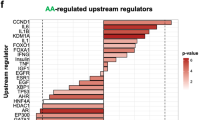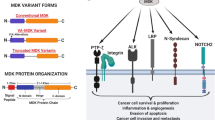Abstract
Maspin, a unique member of the serpin family, is a secreted protein encoded by a class II tumor suppressor gene whose downregulation is associated with the development of breast and prostate cancers1,2. Overexpression of maspin in breast tumor cells limits their growth and metastases in vivo. In this report we demonstrate that maspin is an effective inhibitor of angiogenesis. In vitro, it acted directly on cultured endothelial cells to stop their migration towards basic fibroblast growth factor and vascular endothelial growth factor and to limit mitogenesis and tube formation. In vivo, it blocked neovascularization in the rat cornea pocket model. Maspin derivatives mutated in the serpin reactive site lost their ability to inhibit the migration of fibroblasts, keratinocytes, and breast cancer cells but were still able to block angiogenesis in vitro and in vivo. When maspin was delivered locally to human prostate tumor cells in a xenograft mouse model, it blocked tumor growth and dramatically reduced the density of tumor-associated microvessels. These data suggest that the tumor suppressor activity of maspin may depend in large part on its ability to inhibit angiogenesis and raise the possibility that maspin and similar serpins may be excellent leads for the development of drugs that modulate angiogenesis.
This is a preview of subscription content, access via your institution
Access options
Subscribe to this journal
Receive 12 print issues and online access
$209.00 per year
only $17.42 per issue
Buy this article
- Purchase on Springer Link
- Instant access to full article PDF
Prices may be subject to local taxes which are calculated during checkout



Similar content being viewed by others
References
Zou, Z. et al. Maspin, a serpin with tumor-suppressing activity in human mammary epithelial cells [see comments]. Science 263, 526–529 (1994).
Zhang, M., Maass, N., Magit, D. & Sager, R. Transactivation through Ets and Ap1 transcription sites determines the expression of the tumor-suppressing gene maspin. Cell Growth Differ. 8, 179–186 (1997).
Pemberton, P.A. et al. The tumor suppressor maspin does not undergo the stressed to relaxed transition or inhibit trypsin-like serine proteases. Evidence that maspin is not a protease inhibitory serpin. J. Biol. Chem. 270, 15832–15837 (1995).
Sheng, S. et al. Tissue-type plasminogen activator is a target of the tumor suppressor gene maspin. Proc. Natl. Acad. Sci. U. S. A. 95, 499–504 (1998).
Zhang, M. et al. Maspin plays an important role in mammary gland development. Dev. Biol. 215, 278–287 (1999).
Stringer, H.A. & Pannekoek, H. The significance of fibrin binding by plasminogen activator inhibitor 1 for the mechanism of tissue-type plasminogen activator-mediated fibrinolysis. J. Biol. Chem. 270, 11205–11208 (1995).
Zhang, M., Sheng, S., Maass, N. & Sager, R. mMaspin: the mouse homolog of a human tumor suppressor gene inhibits mammary tumor invasion and motility. Mol. Med. 3, 49–59 (1997).
Sheng, S., Pemberton, P.A. & Sager, R. Production, purification, and characterization of recombinant maspin proteins. J. Biol. Chem. 269, 30988–30993 (1994).
Dawson, D.W. et al. CD36 mediates the In vitro inhibitory effects of thrombospondin-1 on endothelial cells. J. Cell Biol. 138, 707–717 (1997).
Lawrence, D.A., Berkenpas, M.B., Palaniappan, S. & Ginsburg, D. Localization of vitronectin binding domain in plasminogen activator inhibitor-1. J. Biol. Chem. 269, 15223–15228 (1994).
Gately, S. et al. Human prostate carcinoma cells express enzymatic activity that converts human plasminogen to the angiogenesis inhibitor, angiostatin. Cancer Res. 56, 4887–4890 (1996).
Volpert, O.V. et al. Captopril inhibits angiogenesis and slows the growth of experimental tumors in rats [see comments]. J. Clin. Invest. 98, 671–679 (1996).
Sheng, S. et al. Maspin acts at the cell membrane to inhibit invasion and motility of mammary and prostatic cancer cells. Proc. Natl. Acad. Sci. U. S. A. 93, 11669–11674 (1996).
Sternlicht, M.D., Kedeshian, P., Shao, Z.M., Safarians, S. & Barsky, S.H. The human myoepithelial cell is a natural tumor suppressor. Clin. Cancer Res. 3, 1949–1958 (1997).
Dawson, D.W. et al. Pigment Epithelium-Derived Factor: A Potent Inhibitor of Angiogenesis. Science 285, 245–248 (1999).
Polverini, P.J., Bouck, N.P. & Rastinejad, F. Assay and purification of naturally occurring inhibitor of angiogenesis. Methods Enzymol. 198, 440–450 (1991).
Tsujii, M. et al. Cyclooxygenase regulates angiogenesis induced by colon cancer cells [published erratum appears in Cell 1998 Jul 24;94(2):following 271]. Cell 93, 705–716 (1998).
Silberstein, G.B. & Daniel, C.W. Investigation of mouse mammary ductal growth regulation using slow- release plastic implants. J. Dairy Sci. 70, 1981–1990 (1987).
Talhouk, R.S., Bissell, M.J. & Werb, Z. Coordinated expression of extracellular matrix-degrading proteinases and their inhibitors regulates mammary epithelial function during involution. J. Cell Biol. 118, 1271–1282 (1992).
Obermair, A. et al. Correlation of vascular endothelial growth factor expression and microvessel density in cervical intraepithelial neoplasia. J. Natl. Cancer Inst. 89, 1212–1217 (1997).
Acknowledgements
The authors thank J. Rosen for his advice and equipment support, N. Greenberg, D. Rowley, and W. Porter for discussion, W. Huss for kindly providing the protocol for CD31 and factor VIII immunostaining. This work is supported by National Cancer Institute grants CA 52750 and CA 64239 to N.B. and a Department of Defense grant (DAMD17-98-1-8028) to M.Z.
Author information
Authors and Affiliations
Corresponding author
Rights and permissions
About this article
Cite this article
Zhang, M., Volpert, O., Shi, Y. et al. Maspin is an angiogenesis inhibitor. Nat Med 6, 196–199 (2000). https://doi.org/10.1038/72303
Received:
Accepted:
Issue Date:
DOI: https://doi.org/10.1038/72303
This article is cited by
-
HDAC5-mediated exosomal Maspin and miR-151a-3p as biomarkers for enhancing radiation treatment sensitivity in hepatocellular carcinoma
Biomaterials Research (2023)
-
Re-evaluation of the myoepithelial cells roles in the breast cancer progression
Cancer Cell International (2022)
-
Stochastic microsensors based on modified graphene for pattern recognition of maspin in biological samples
Analytical and Bioanalytical Chemistry (2022)
-
Unraveling the functional role of DNA demethylation at specific promoters by targeted steric blockage of DNA methyltransferase with CRISPR/dCas9
Nature Communications (2021)
-
Antimicrobial Peptide JH-3 Effectively Kills Salmonella enterica Serovar Typhimurium Strain CVCC541 and Reduces Its Pathogenicity in Mice
Probiotics and Antimicrobial Proteins (2019)



